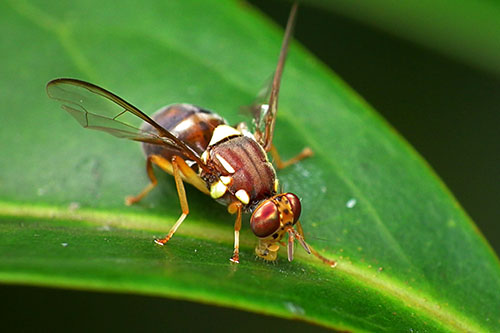
A Queensland fruit fly. Image: James Niland
Releases sterile fruit flies at two Australian locations have significantly reduced Queensland fruit fly numbers.
The pilot, which ran from September 2019 to mid-April 2020 in Hillston, NSW and Cobram, VIC involved releasing sterile fruit flies each week from a plane and is part of the Hort Innovation research project – Post Factory Pilot of SITPlus Fly production.*
Cobram agronomist Russell Fox said, “The sterile fruit fly releases have worked well so far and are widely supported by local growers and community. The program is a very useful complement to the regional fruit fly management strategy.”
Goulburn Murray Valley Regional Fruit Fly Coordinator Ross Abberfield said, “The timing of the SITPlus project has been ideal to fit in with our area wide management activity.
“In Cobram, the sterile fruit fly releases contributed to an 83% reduction in Queensland fruit fly activity.”
Plant and Food Research New Zealand Plant and Food Scientist, Lloyd Stringer said, “The rate of capture of wild male Queensland fruit fly in traps is on average 10 times higher in Mooroopna than in Cobram where sterile flies are being used.”
In Hillston, initial analysis indicates wild Queensland fruit fly were detected in very low numbers in town and almost undetected on nearby farms. Residents claimed they were able to eat their backyard fruit for the first time in years.
The project is a pilot that enables grower groups to confidently consider the Sterile Insect Technique, or SIT, for management of Queensland fruit fly. The project is testing efficacy of Queensland fruit fly SIT in the field and rearing sterile flies in localised centres. It’s also testing the development of quality control procedures in the dedicated rearing out centres. The project also underpins economic modelling for future operational Queensland fruit fly SIT use.
Hort Innovation SITPlus Program Director Dan Ryan said, “A well-established method of pest insect control, the sterile insect technique is based on the mass rearing, sterilisation, and release of targeted pest insects. Once released in the environment, the sterile insects’ mate with their wild counterparts which disrupts reproduction and suppresses pest population numbers.”
Ross Abberfield said, “In the Goulburn-Murray Valley, an area-wide management program coordinated through Moira Shire Council has been in place since June 2017. This activity has included the removal of feral fruit trees, abandoned orchards, and neglected urban trees on both public and private land. This non-SIT area-wide management program activity has shown that Queensland fruit fly activity has reduced by 57%.”
Dan Ryan said, “The area-wide program has been an important contribution to achieving Cobram’s outstanding success.”
Season two of the SITPlus Pilot begins in mid-September and will continue through to April 2021.
*Funded through the Hort Innovation Hort Frontiers Fruit Fly Fund, FF17001 “Post Factory Pilot of SITPlus Fly production” is a collaborative research project with co-investment from Macquarie University, South Australian Research and Development Institute, New South Wales Department of Primary Industries, Agriculture Victoria, Tasmanian Department of Primary Industries, Parks, Water and Environment, Plant & Food Research New Zealand and Southern Cross Farms as well as contributions from the Australian Government.
Acknowledgement: this article was reproduced from a media release by Hort Innovation.